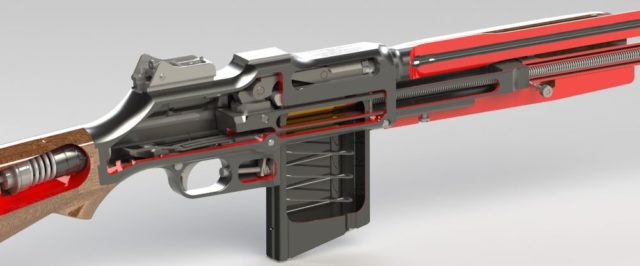A Beginners Guide to Starting to Design Your Own Guns
I am often asked what someone needs to be a gun designer or how to get into the industry. I have a degree in Mechanical Engineering but you do not necessarily need one to design guns. Two of the country’s greatest gun designers did not have a degree at all. John Moses Browning and Eugene Stoner did not have any formal education in engineering. I am not saying that an engineering degree will not help but it is not required as they proved. The lack of an engineering degree usually means that you will eventually need engineering support if you wish to bring the design to market. Browning and Stoner were both backed by large number of engineers that did the numbers crunching and making a design manufacturable for production.
So What Do You Need?
A good knowledge base helps. If there is one thing you don’t want to do when brain storming a new gun design is to find out it’s already been thought of and was a terrible disaster or finical flop. So knowing about previous designs helps. The best tomes are a set of books written by Colonel George M. Chinn. The books were originally published in 1951 by the department of the Navy but have since been released to the public. “The Machine Gun” consists of 5 volumes and covers almost all mechanisms used successfully in machine guns. There are wonderful illustrations showing each mechanism and how they work. Volume 3, 4, and 5 are available on the internet, if you search, in pdf file form for free.
There are many books and papers that will help you with design and how to analyze them. The various books I’ll mention are available on the internet for free in pdf format if you search for them.
- Rheinmetall Handbook on Weaponry – This is a handbook that the German armaments company Rheinmetall use to give away for free. They no longer do this but it is still a fantastic resource for various weapon system designs and how to analyze them.
- Engineering Design Handbook, Gun Series, Automatic Weapons, Jan 1972 – AMCPP 706-260 – This is a handbook written by the US military that details how to analyze/design various automatic weapon systems. This obviously applies to semi automatic designs as well.
- US Army Weapons Command Research & Engineering Directorate Small Arms Systems Laboratory, Technical Notes, Small Arms Weapons Design. May 1968 – Another US military book on small arms designs.
- Engineering Design Handbook, Ballistics Series, Interior Ballistics of Gun, Feb 1965 – AMCPP 706-150 – Title pretty much says it all. When designing an semi/automatic firearm internal ballistics is critical since you need to know pressures, gas volumes and temperatures to adjust the design.
- Engineering Design Handbook, Gun Series, Muzzle Devices, May 1968 – AMCPP 706-251 – Reading this will be eye opening at how many gun muzzle brakes are poorly designed. This is also useful when designing suppressors.
- C.I.P. -Material Quality and Wall Thickness of Barrel and Chamber of Small Arms – this is a paper on good practices when determining the required barrel thickness for various cartridges.
- SAAMI – Sporting Arms and Ammunition Manufacturers Institute – standards agency for small arms in the US. Below are the standards they have and give out on their website.
- 200 – Smokeless Powder
- 201 – Primers
- 202 – Sporting Ammunition
- 205 – Pistol Ammunition
- 206 – Rifle Ammunition
- 207 – Abusive Handling
- 208 – Rimfire Ammunition
- 209 – Shot Shells
- C.I.P. – European counterpart to SAAMI.
- C.I.P. – Belted Cartridges
- C.I.P. – Cartridges for Alarm Weapons
- C.I.P. – Cartridges for Industrial Use
- C.I.P. – Cartridges for Other Weapons
- C.I.P. – Caseless Cartridges
- C.I.P. – Dust Shot Cartridges
- C.I.P. – Pistol and Revolver Cartridges
- C.I.P. – Rimfire Cartridges (Crusher)
- C.I.P. – Rimfire Cartridges (Transducer)
- C.I.P. – Rimless Cartridges
- C.I.P. – Rimmed Cartridges
- C.I.P. – Shot Cartridges
Design Software
Guns obviously have been designed with paper and pencil but I have found good 3D design software makes it much easier. The top 3D design software packages will also allow you to perform FEA (Finite Element Analysis) on items you design to see how they might fail under loads.
There are several different 3D design software available these days. Some are available for free and/or for student use but they are typically crippled in some manner that restricts features. I personally use Solidworks and it seems to be the most commonly used 3D design software in the firearms industry.
Mongo
www.John1911.com
“Shooting Guns & Having Fun”
- The Safe is Full Again! - January 7, 2025
- These Old Guns - October 11, 2024
- Expensive Optics Cheap - August 18, 2024






